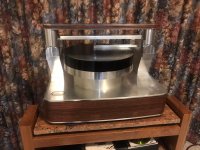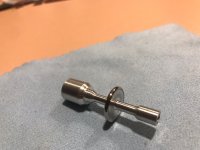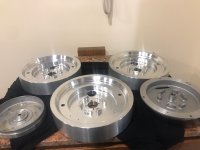@warrjon just wandering how your build is coming along. The last we saw were those beautiful CNC parts.
S.
I've been away sailing so nothing has happened in my world. I'm going to see Kev on Saturday he has a few wheels made for me to test. We are getting there slowly. The bridge is drawn up in CAD and the rail carriers are made.
Truepoint has closed it's website so we had the axles ground and polished locally. The finish on them is mirror but they did cost $85 each x 4 so not cheap.
Thanks for the link Mike, I’ll see if there is any info on that thread about phenolic paper boards. A lot more affordable, £25 per sheet at my local electrical shop. I even think toolstation stock it (UK). I agree, there must be an affordable DIY approach to plinth building. After all Permali and the like, were not conceived to be damping panels it’s just lucky for the audio community that they do possess intrinsic damping properties.
S.
My SP10 plinth is Permalli (similar to Panzerholtz) it has fantastic damping properties. I tested the SP10 motor in the previous resin/bentonite plinth and then when I swapped it to the Permalli. The Permalli had 20dB less energy above 200Hz in an impulse test.
Here are a few pics of the new TT and LTA mocked up to see what it'll look like.
Pic 2 is the new wheels, Tyre is hardened tool steel fitted to an aluminium hub. The last pic are the tyres before and after having the centers wire cut. Next operation is to part off the ends of the axles and jig bore for the carbide pivot pins.



Pic 2 is the new wheels, Tyre is hardened tool steel fitted to an aluminium hub. The last pic are the tyres before and after having the centers wire cut. Next operation is to part off the ends of the axles and jig bore for the carbide pivot pins.



You always need to remember that all this tool, hardened steel needs to be rolled along rails by the thinnest tip of a diamond needle in a pliable vinyl material.
No matter how smoothly the wheels and rails are polished, it will be very difficult for the diamond tip of the needle to set this “railroad” in motion, especially if there is eccentricity of the vinyl record, and eccentricity is almost always present to a greater or lesser extent.
No matter how smoothly the wheels and rails are polished, it will be very difficult for the diamond tip of the needle to set this “railroad” in motion, especially if there is eccentricity of the vinyl record, and eccentricity is almost always present to a greater or lesser extent.
Hi Havun,
The problem of high bearing friction is not anywhere near the problem that you suggest it to be, even on severely eccentric records.
Whilst developing the type of wheels and bearings being built by Warren (Warrjon) I built a test rig for measuring friction. I used a combination of mathematical modelling and these measurements to determine the expected deflection of the cantilever due to eccentricity. These models included not just bearing friction but also the inertial effect of the higher carriage mass.
Eccentricity not only moves the record from side to side it also moves it forwards and backwards. The forward and backwards movement is actually the more problematic as it causes the speed of the record past the stylus to vary (wow) and causes a lateral tracking error. For a 0.5mm eccentricity, which would result in a 1mm back and forth movement, will result in a maximum tracking error of ~0.2° at the start of the record and ~0.46° at the end. 0.5mm is a pretty severe eccentricity, way above DIN specs.
On the same record with a 0.5mm eccentricity , my arm which is very similar to Warren's, would result in a maximum cantilever deflection of around 0.4°. This may, at first glance, look like a large deflection. I also calculated the deflection for typical pivoted arms and they came just below this figure 0.25-0.3°. This is assuming that anti-skating is set as close to perfectly as possible.
Now you have to remember that this is on a severely eccentric record. On a perfectly centered record the error due to inertia goes away leaving only bearing friction which would result in a deflection of ~0.2°.
These deflections were calculated based on my old cartridge, an Ortofon 2M Black which has a high compliance of 22μm/mN. My current cartridge has a compliance of 16μm/mN. This will result in the calculated deflections being reduced by almost a quarter.
Meanwhile a 12" pivoted arm would have an average tracking error of over 1°. It would be even higher with a 9" arm. Regardlessof ccompliance.
It must also be pointed out that, due to the higher lateral effective mass, the amount that the cartridge body moves will be, especially in the bass, much lower than with a conventional pivoted arm.
I did take a video of my old cartridge tracking a record where I had filed out the centre hole to give an eccentricity of 1.6mm. This resulted in the carriage moving back and forth by 3.2mm (1/8").
Hopefully this link works.
As you can see virtually no cantilever definition is visible.
The video corroborates my calculations. It's not an issue.
The problem of high bearing friction is not anywhere near the problem that you suggest it to be, even on severely eccentric records.
Whilst developing the type of wheels and bearings being built by Warren (Warrjon) I built a test rig for measuring friction. I used a combination of mathematical modelling and these measurements to determine the expected deflection of the cantilever due to eccentricity. These models included not just bearing friction but also the inertial effect of the higher carriage mass.
Eccentricity not only moves the record from side to side it also moves it forwards and backwards. The forward and backwards movement is actually the more problematic as it causes the speed of the record past the stylus to vary (wow) and causes a lateral tracking error. For a 0.5mm eccentricity, which would result in a 1mm back and forth movement, will result in a maximum tracking error of ~0.2° at the start of the record and ~0.46° at the end. 0.5mm is a pretty severe eccentricity, way above DIN specs.
On the same record with a 0.5mm eccentricity , my arm which is very similar to Warren's, would result in a maximum cantilever deflection of around 0.4°. This may, at first glance, look like a large deflection. I also calculated the deflection for typical pivoted arms and they came just below this figure 0.25-0.3°. This is assuming that anti-skating is set as close to perfectly as possible.
Now you have to remember that this is on a severely eccentric record. On a perfectly centered record the error due to inertia goes away leaving only bearing friction which would result in a deflection of ~0.2°.
These deflections were calculated based on my old cartridge, an Ortofon 2M Black which has a high compliance of 22μm/mN. My current cartridge has a compliance of 16μm/mN. This will result in the calculated deflections being reduced by almost a quarter.
Meanwhile a 12" pivoted arm would have an average tracking error of over 1°. It would be even higher with a 9" arm. Regardlessof ccompliance.
It must also be pointed out that, due to the higher lateral effective mass, the amount that the cartridge body moves will be, especially in the bass, much lower than with a conventional pivoted arm.
I did take a video of my old cartridge tracking a record where I had filed out the centre hole to give an eccentricity of 1.6mm. This resulted in the carriage moving back and forth by 3.2mm (1/8").
Hopefully this link works.
As you can see virtually no cantilever definition is visible.
The video corroborates my calculations. It's not an issue.
I should add, when I was developing my arm I did originally use ball-race bearings, similar to those used by Clearaudio. Even using very high quality ceramic hybrid bearings resulted in friction that was 4 times as high as my current design. The Ball-race bearings also varied a lot as they rotated depending on how the balls were positioned. My jeweled pin bearings are much more consistent.
The main problem with the ball-race bearings is chatter due to the unloaded balls being loose and able to move around.
Another advantage of the pin bearing design is they couple the carriage to the rail more effectively. The carriage is basically mounted on spikes.
You will find that the majority of the most highly rated arms use spikes for their main bearing elements.
Kuzma, SAT, Graham etc.
Niffy
The main problem with the ball-race bearings is chatter due to the unloaded balls being loose and able to move around.
Another advantage of the pin bearing design is they couple the carriage to the rail more effectively. The carriage is basically mounted on spikes.
You will find that the majority of the most highly rated arms use spikes for their main bearing elements.
Kuzma, SAT, Graham etc.
Niffy
I can assure you that the camera was being held completely still.Hello, I didn’t find the video very informative, it feels like you’re just moving the camera left and right, because in the frame not only the Ortofon head moves, but also everything behind it.
The frame is zoomed in so that the end of the cantilever is clearly visible. Unfortunately this does mean that the carriage, which of course moves with the cartridge, fills most of the rest of the frame. If I zoomed out enough to include a stationary reference you would no longer be able to see the cantilever, which would defeat the purpose of the video.
As a bonus the video also shows how well my clamping system works, there is barely any vertical movement.
Niffy
My design has come a long way from ball bearings.
It runs on tungsten carbide rails. The wheels have tungsten carbide rims on titanium and aluminum hubs. The bearings are sapphire vees with tungsten carbide pivots.
The key to performance is hardness of the materials. Sapphire and tungsten carbide are two of the hardest engineering materials available.
Unfortunately diamond isn't available in the sizes required for this project.
Niffy
It runs on tungsten carbide rails. The wheels have tungsten carbide rims on titanium and aluminum hubs. The bearings are sapphire vees with tungsten carbide pivots.
The key to performance is hardness of the materials. Sapphire and tungsten carbide are two of the hardest engineering materials available.
Unfortunately diamond isn't available in the sizes required for this project.
Niffy
Yes it started life as an SP10mk2. The only SP10 bits that remain are the motor stator, magnet and electronics. A completely new motor housing has been machined to increase rigidity and incorporate an inverted bearing. The electronics will be moved from the SP10 chassis to a custom made enclosure.Just to get this straight.
That is an SP10 right?

One would think lowest moving mass and friction are pre requisites, that said Clearaudio have managed it for decades. I look forward to more engineering porn.
Friction and sticktion yes but not mass so long as the mass is not so great that inertia become a problem. It is actually inertia usually called Effective Mass (EM) in audio that holds the cartridge body still. If the system had ZERO EM then the cartridge would have no output.
@niffy 's design does a couple of things. It has a very stiff carriage moving what would be arm wand resonance out of the audio band, WOW is this audible. Next is high lateral EM holding the cartridge still allowing the stylus to track bass modulation better, this arm digs deep. with well damped lower vertical EM preventing the carriage bouncing the cartridge.
The driving force that moves the carriage back and forth is created by the positive castor of the stylus being forward of the pivot (cart suspension) this works like a shopping trolley wheel so the carriage follows the diamond.
- Home
- Source & Line
- Analogue Source
- DIY linear tonearm